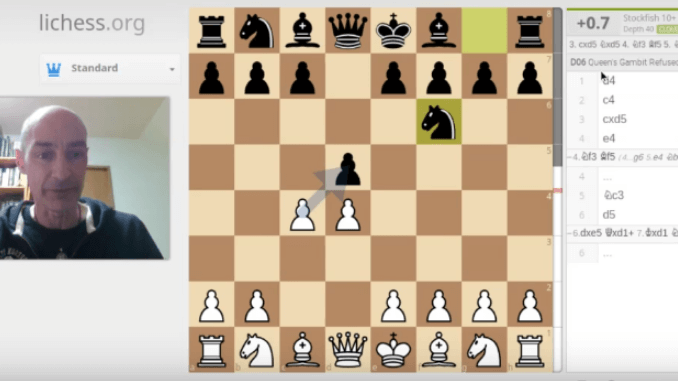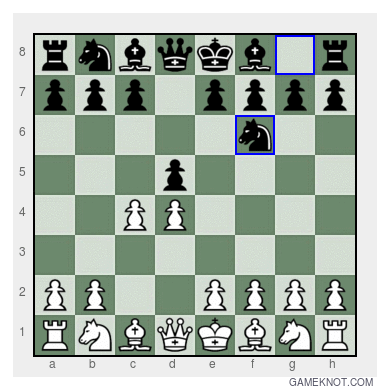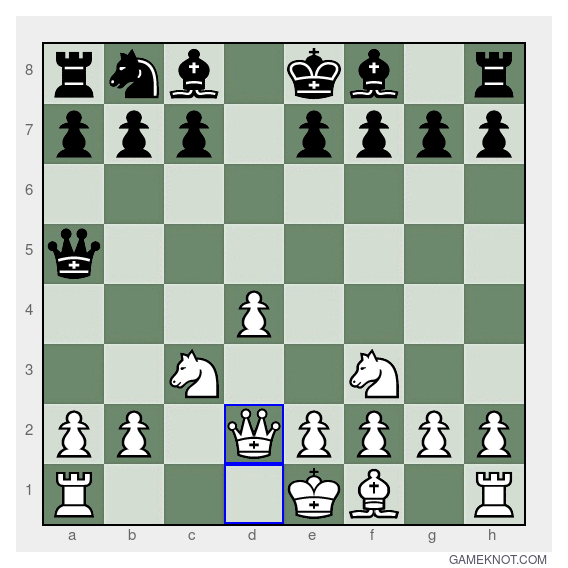
If there’s ONE Easy Chess Tip I’d like to impress upon you it is this: When you are playing as Black against a d4 opening, do NOT go for the Marshall Defence!
Just a quick recap… The Marshall Defence occurs when Black moves his Knight to f6 on the second move in this sequence:
- d4 d5
- c4 Nf6
It is an inferior defence that poses no problems for White. Indeed, against an experienced player it practically guarantees that Black will never gain parity, will fail to gain control of the centre and will most likely go on to lose the game.
Yet, the Marshall Defence is a relatively common response to the Queen’s Gambit in casual chess games, probably because it seems to make sense to develop a Knight early on, and a Knight on f6 is at least defending the d5 pawn.

However, if you are playing the Queen’s Gambit as White and are faced with the Marshall Defence, then you have a clear response:
3. c x d5
What if Black Recaptures with the Queen?
If Black wishes to recapture immediately he has a choice of 3…Nxd5 or 3… Qxd5. Recapturing with the Knight is more usual as it is “common knowledge” that moving the Queen out too early can be risky. If Black does go for 3…Qxd5, there follows:
4. Nc3 immediately attacking Black’s Queen and developing a minor piece. After that, White can usually continue with natural developing moves such as Nf3 and Bd2. For example:
4. Nc3 Qa5 5. Nf3 Ne4, 6. Bd2 Nxd2 7. Qxd2 giving White the centre and a developmental lead in exchange for Black’s Bishop pair.

gives white the centre and a developmental lead
How To Respond if Black Recaptures to the Knight?
More often than not, Black will respond to 3. cxd5 by recapturing with his Knight, 3. …Nxc5. In that event, it looks obvious or natural to advance your King’s pawn to e4, which is what I did in a recent game to good effect, as you can see in the video below.
However, although 4. e4 will usually bring you good results against casual chess players, and is actually recommended by the LiChess engine (as you can see in the video), I do not recommend that you use 4. e4 in this instance against more experienced players! (Mind you, why on earth more experienced players would want to respond to the Queen’s Gambit with the Marshall Defence beats me!)
I blogged about the craziness that can occur if you play 4. e4 after 3…Nxd5 in the Marshall Defence a few weeks ago.
Instead, I recommend that you follow John Watson’s advice and play the finessing move, 4. Nc3 as I explain in my other blog post on the topic.
Bluffing with 4. e4 against the Marshall Defence!
As I mentioned earlier in this blog post, in a casual game of pub chess, a move such as 4. e4 will probably work quite well for you. It is all part of the “pub chess bluffery” ethos in which you go against the best chess advice to “play the board, not the player” and engage in psychological warfare. Here’s how it turned out for me in a recent game in which my opponent responded to my d4, c4 opening with the Marshall Defence: